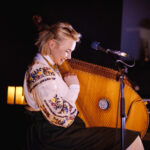My wife Daria and I will be spending most of today helping some of our younger cousins learn how to master the fine art of Ukrainian cooking, and in particular how to make varenyky and borscht. I am the resident varenyky (perogy) and deruny (potato pancakes) maker in our family and my wife makes a superb borshch from a recipe inherited from her Baba and adapted over the years to our tastes and to modern cooking technology, notably our modern Instapot pressure cooker.
Ukrainian cuisine has become well established in the Canadian culinary repertoire, reflecting the influence of Canada’s large Ukrainian immigrant population over the past century. I grew up on a rich diet of varenyky, deruny, patychky (Ukrainian shishkabobs), holubtsi (cabbage rolls), nalysnyky (crepes), kobassa, kasha, fried kapusta (sauerkraut), and various other Ukrainian culinary delights, and over the years, my wife and I have continued to make and enjoy these traditional foods.
Learning how to make all these dishes has often proved to be a challenge. My mother, who was an extraordinary cook, as most Ukrainian women of her generation were, did not have a recipe book. All the necessary details on how to prepare these foods resided in her head in her prodigious memory banks. Further, her recipes did not encompass precise measurements of anything – she added ingredients and seasonings according to visual approximations and according to taste. Asking her for a detailed recipe was a futile endeavour. She did not use measuring spoons or cups. Her measuring tools were her experienced eye and discriminating taste. She added ingredients and seasonings “do smaku” (according to taste) and these were not easily translated into teaspoons, cups, ounces or grams.
Regrettably, while she was still alive, I was more interested in consuming what she made rather than preparing it, and it was only after she had passed away, that my interest in actually making these wonderful dishes became important. Since then, through trial and error, and with the help of my trusty, indispensable copy of Savella Stechishin’s book “Traditional Ukrainian Cookery”, I have become fairly adept at preparing Ukrainian food, be it making varenyky or baking a traditional and ornate korovai (ceremonial bread). As well as enjoying this traditional ethnic cuisine, I find that the actual preparation of it is in many ways a psychologically therapeutic and satisfying pastime.
My favourite and most frequently made Ukrainian dish is of course varenyky, or perogies as most Canadians call them. These delectable dumplings can be made with a variety of fillings, the most common being potato and cheddar cheese, fried sauerkraut, mushrooms or cottage cheese. There are also dessert variations that are filled with blueberries, cherries or other fruits. I have through experimentation extended my repertoire of fillings to include pulled pork, lobster and shrimp.
I have over the years tried out many different varenyky dough recipes, as it seems that every Ukrainian cook seems to swear by a different combination of ingredients for the dough itself. I have settled on a very simple, yet versatile and reliable dough made with just two ingredients, namely full fat sour cream and flour, in the ratio of one cup sour cream to two cups floor. I got this recipe from Fr. Anton, the parish priest in St. Catharines, who also happens to be an extraordinarily talented chef and is responsible for all the catering at the parish hall.
Second on my list of Ukrainian comfort foods that I love to make are deruny or potato pancakes, and the go-to recipe for this comes from Stechishin’s Traditional Ukrainian Cookery cookbook. It is essentially grated potatoes and onions, with two eggs mixed in and a little flour and baking powder added to the mix. What is critical is that the potatoes need to be grated and not mushed up in a food processor or blender which seems to be a common practice with many Ukrainian cooks. Texture is particularly important when it comes to making good potato pancakes.
Borshch is my wife’s domain, and after having fumbled through many batches with questionable results, I leave the making of borshch to her. What is distinctive about her version is that it is completely vegetarian, dispensing with the usual soup bones that most Ukrainians throw into their recipes. Even without the additional meat flavouring derived from the bones, her borshch is very flavourful and rich tasting. She has also cut preparation time considerably by using our pressure cooking Instapot.
I would strongly recommend that everyone try making some of these Ukrainian favourites, whether you have Ukrainian chromosomes or not. You can now find many recipes and instructions for doing so on the Internet. Failing that, most Canadian grocery stories now sell frozen perogies and cabbage rolls, and in most Canadian cities with a significant Ukrainian population, many of the Ukrainian church halls regularly sell homemade Ukrainian food. Fr. Anton’s version at the St. John’s Ukrainian Catholic Church Hall in St. Catharines comes particularly highly recommended.
Share on Social Media

































